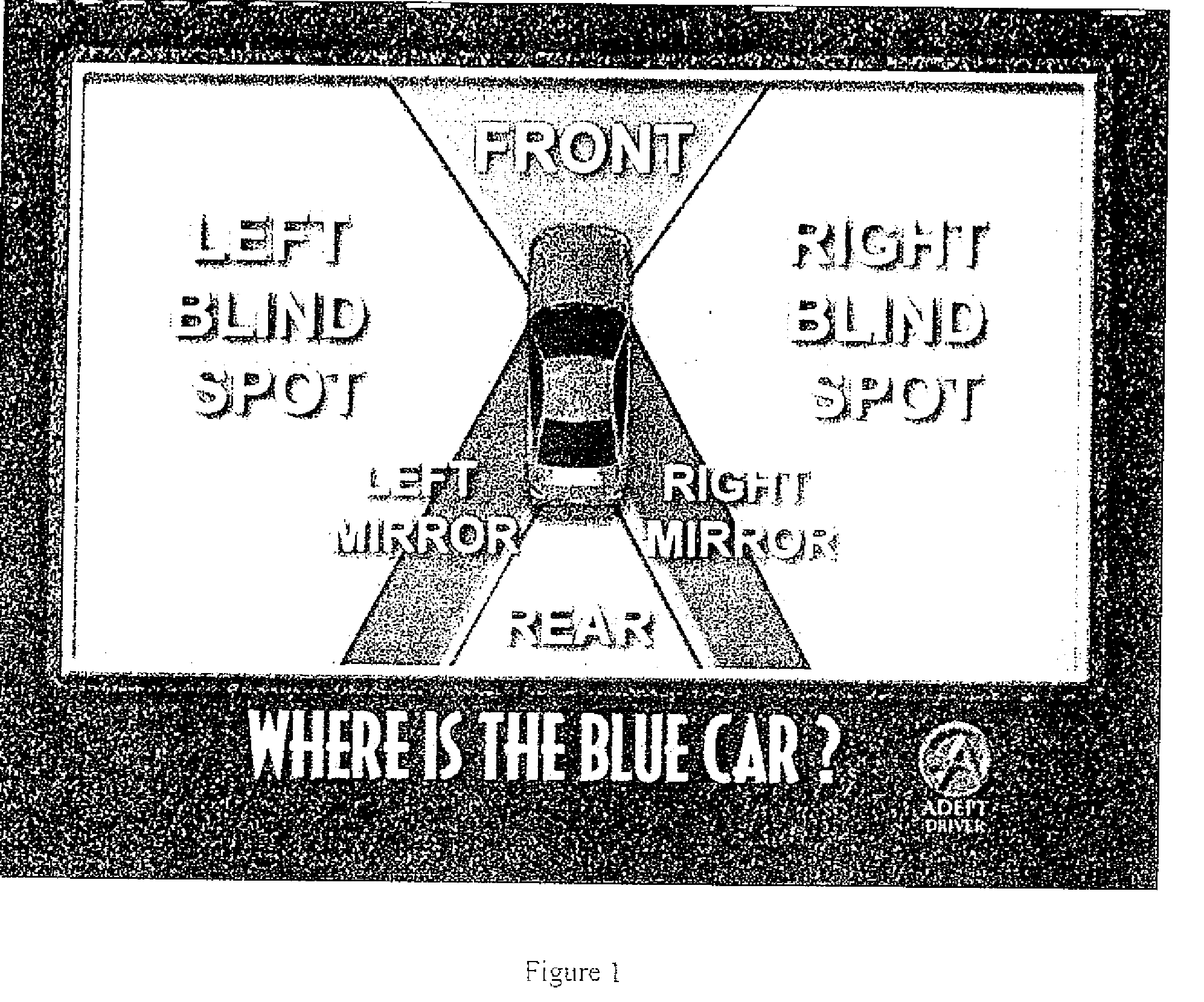Driver Training System
a technology for driving and training, applied in the field of systems and methods for assessing and training automobile drivers, can solve the problems of increasing traffic citations, elderly drivers are more likely to get multiple-vehicle crashes at intersections, and elderly drivers are not as well dealt with. achieve the effect of high driving skill and ability
- Summary
- Abstract
- Description
- Claims
- Application Information
AI Technical Summary
Benefits of technology
Problems solved by technology
Method used
Image
Examples
example i
Workout Session #1
[0073]A: Time: 60 minutes
[0074]B: Session Objectives:
[0075]To introduce the four camera point of view driving simulation system.
[0076]To introduce key facts about the issues of impairment in senior drivers
[0077]To distribute the “Program Materials” and provide a high-level overview of key program components
[0078]C: Instructional Elements / Sequence:
[0079]1. Warm-Up: Trigger Video: “Driving and the Aging Population” (2-3 minutes)
[0080]D: Description:
[0081]1. Warm-Up: Trigger Video: “Safe Driving for Seniors” (2-3 minutes): This introductory piece shows ______.
[0082]2. Trigger Video “Come One Let's Go” (2-3 minutes): In this video, a typical senior driving scenario is viewed to exemplify the introduced concepts.
example ii
Computer Familiarity and Self Assessment
[0083]A: Time: 60 minutes
[0084]B: Session Objectives:
[0085]To make the drivers comfortable interacting with the computer technology and provide them with an opportunity to navigate and practice.
[0086]To introduce concepts of driving introduced in the Orientation Video and Workout
[0087]To develop the driver's understanding of Visual Search techniques as the cornerstone of safe and skillful driving
[0088]To allow the driver to apply and practice Visual Search techniques in a variety of situations
[0089]To develop a database of senior responses for diagnostic and prescriptive study and remediation.
[0090]C: Instructional Elements / Sequence:
[0091]1. Logging On
[0092]2. CBT #0: Introduction: Preview and Practice (15 minutes)
[0093]3. CBT #1: “Driving With Your Eyes Wide Open” (15 minutes)
[0094]4. CBT #2: “Taking A Closer Look”. (30 minutes)
[0095]D: Description:
[0096]1. Logging On
[0097]When the driver signs in and enters his / her password, he / she sees a Ho...
example iii
[0119]Once the driver has been assessed a program for prescriptive instruction is develop for the driver. This practice session / tutorial may model the driving practice sessions. The prescriptive instruction may include various elements, a few of which are summarized here.
[0120]1. “Driving With Your Eyes Wide Open” (15 minutes)
[0121](a) Purpose
[0122]The overall purpose of this CBT is to:
[0123]Reinforce visual search as the bedrock component of visual cognition
[0124]Break down visual search into its components—search to front, back, sides
[0125]Provide elementary visual search practice
[0126](b) Conceptual World View / Visual Search
[0127]The “film within a film” now picks up on the first day of shooting. The discussion regards the differences that occur in aging drivers abilities. The key point / question is now, “In which ways do various impairments to driver affect the ways they can anticipate and stay out of trouble?” The point comes out in the discussion that the failure t...
PUM
 Login to View More
Login to View More Abstract
Description
Claims
Application Information
 Login to View More
Login to View More - R&D
- Intellectual Property
- Life Sciences
- Materials
- Tech Scout
- Unparalleled Data Quality
- Higher Quality Content
- 60% Fewer Hallucinations
Browse by: Latest US Patents, China's latest patents, Technical Efficacy Thesaurus, Application Domain, Technology Topic, Popular Technical Reports.
© 2025 PatSnap. All rights reserved.Legal|Privacy policy|Modern Slavery Act Transparency Statement|Sitemap|About US| Contact US: help@patsnap.com


